With the bulk of this offseason’s free-agent spending complete, I thought it might be interesting to look back at some spending trends over the last several free-agent periods. There was a big jump in overall spending in 2013-14, and the market has continued to grow since. While the total spend decreased last year, AAV continued to rise, and we’re headed for new records in both total outlay and dollars per year this winter.
One interesting aspect of the 2015-16 market, of course, has been the general success experienced by pitchers. While several notable bats have come in under expectations, pitching flew off the shelves and still seems in demand. True, Yovani Gallardo has yet to sign, but reports suggest he could still be in line for over $40MM. It’s not clear the same can be said for fellow qualifying-offer-bound hitters Ian Desmond and Dexter Fowler, each of whom came into the winter with greater anticipated earning power than Gallardo.
So, how have spending patterns shifted over the past three years? Let’s go to the data. (For what it’s worth, I tried to break things down further, but was ultimately uncomfortable with the lines I would’ve been forced to draw between, say, relievers and starters or infielders and outfielders.)
(Image link for mobile app users..)
Clearly, there’s a shift in results. Let’s take a look at a few of the key figures across the three-year period, in graph form. To begin, we have witnessed a major swing in the total outlay made to pitchers as opposed to hitters:
(Image link.)
Free-agent pitchers have posted some notable gains by other measures, too. Consider the average length of contract:
(Image link.)
There’s also been a bump in AAV that closed down a gap that existed at the start of the period in question:
(Image link.)
It’s possible that this is simply a straightforward reflection of the quality of the players available. Let’s have a look at the pitchers who were able to command $30MM+ overall commitments (that includes posting fees, where applicable):
2013-14
Masahiro Tanaka ($175MM), Ubaldo Jimenez ($50MM), Matt Garza ($50MM), Ricky Nolasco ($49MM), Jason Vargas ($32MM), Scott Feldman ($30MM)
2014-15
Max Scherzer ($210MM), Jon Lester ($155MM), James Shields ($75MM), Ervin Santana ($55MM), Brandon McCarthy ($48MM), David Robertson ($46MM), Francisco Liriano ($39MM), Andrew Miller ($36MM)
2015-16
David Price ($217MM), Zack Greinke ($206.5MM), Johnny Cueto ($130MM), Jordan Zimmermann ($110MM), Jeff Samardzija ($90MM), Mike Leake ($80MM), Wei-Yin Chen ($80MM), Ian Kennedy ($70MM), Scott Kazmir ($48MM), Kenta Maeda ($45MM), J.A. Happ ($36MM), John Lackey ($32MM), Darren O’Day ($31MM)
And here’s what that looks like in table form, to get a visual sense of the impact this volume and quality of players may have had on driving salary.
(Image link.)
It’s possible that some of the inclination toward pitching is the result of an imbalance between the volume and quality of hitting versus pitching prospects entering the game right now. Fangraphs’ Jeff Zimmerman wrote a couple of years ago about the shifting aging curve for batters, and that could play a role in the trend as well. Alternatively, the increased demand for arms could be attributable to the very thing (enhanced injury risk) that makes them such a risky investment in the first place.

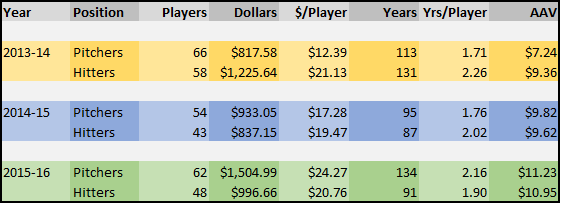
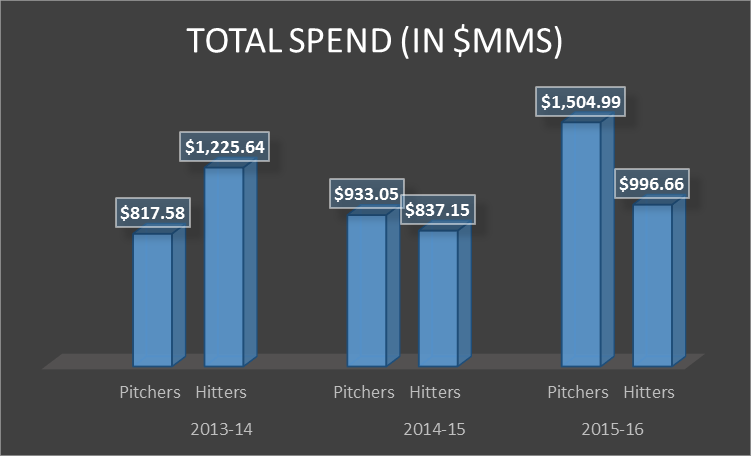
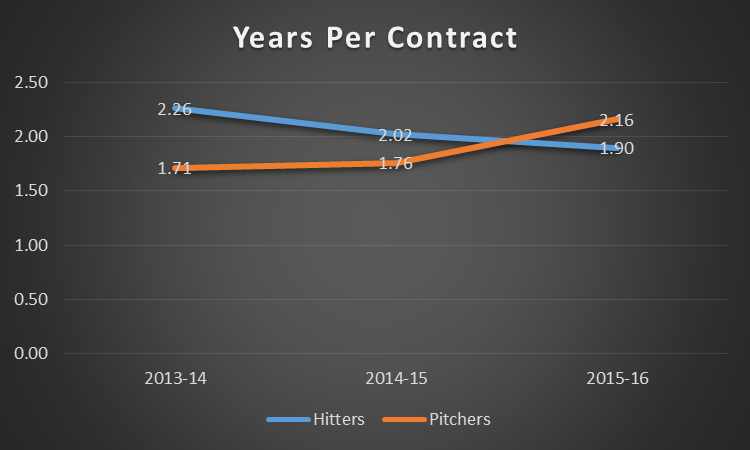
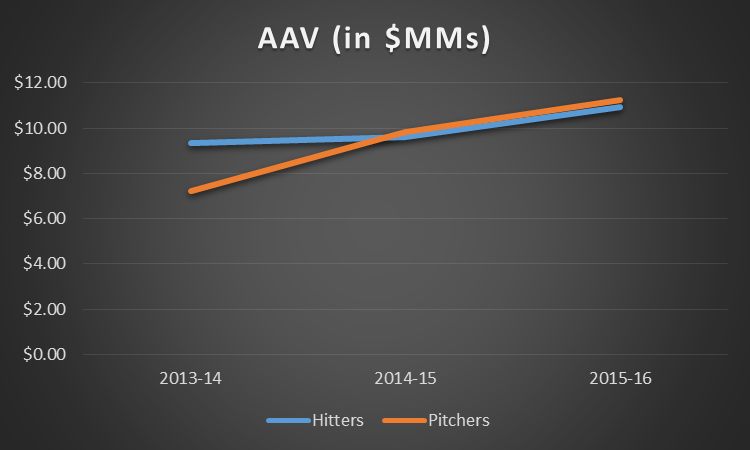
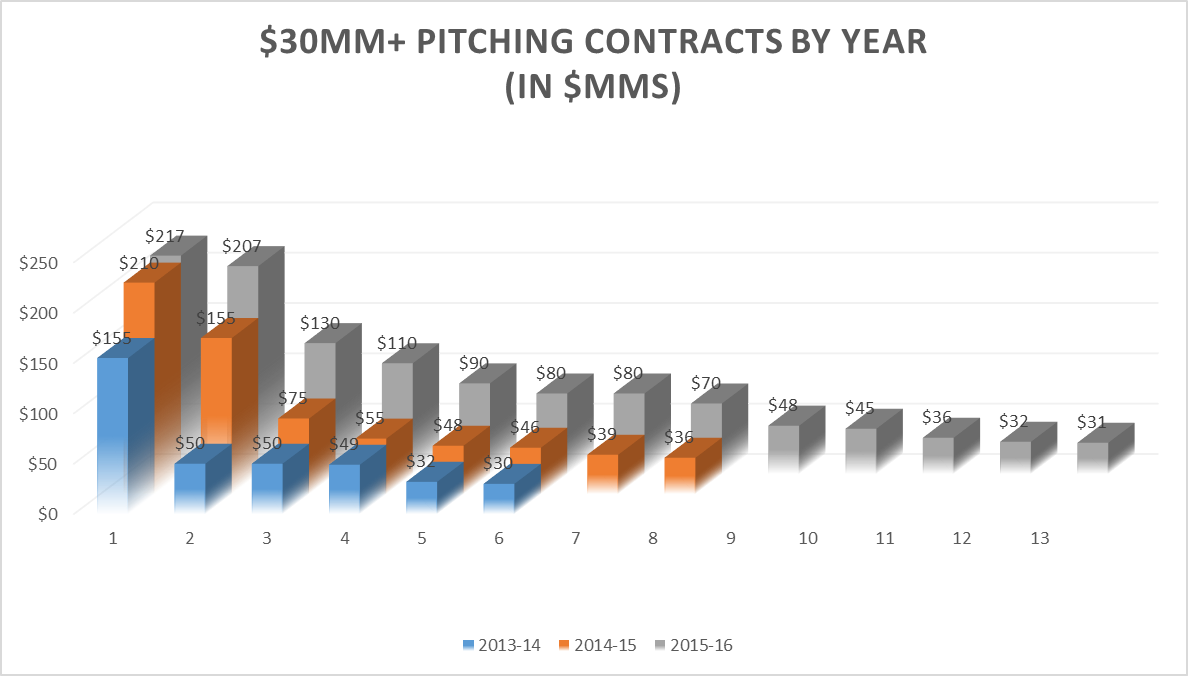
I would suggest that it’s the increasing fickleness of pitchers health, seeing healthy pitchers with track records is a huge commodity playing a large part as well. The fa market this year definitely plays a part as well with so many excellent pitchers.
Paying exorbitant money long term for starting pitchers is a huge mistake. All you have to do is long at the last 10 years. For every success story there seems to be 9 owners with buyer’s remorse. Not a good idea.
Even though offense has become more and more scarce every passing year, it seems, the gulf between paying for pitchers and hitters has widened in favor of pitching this offseason. It’s kind of a confusing trend IMO. I know teams like the Mets and Royals prove that good pitching can lead to success in the postseason, but this assumption that good pitching beats good hitting every time just isn’t always true.
I think eliminating PEDs has something to do with this. Hear me out. Youth and athleticism is now the mantra. Controllable major league talent seems to be a common element to winning at MLB level. Teams appear to be drafting the best available player vs. filling by position. The fact that there are more position players available in the draft, the liklihood is that more will get drafted vs. Pitchers. The result is a surplus of quality bats being developed at all levels of pro ball. When a team promotes the bats, the missing components are pitching. I would be interested in seeing a chart listing how many early round position players performed to expectation vs. pitchers.
peds still in play.
Agreed
Yep
I think it’s just a matter of luck of the draw when it comes to who is a FA and this past year, we had a lot of good pitchers on the market and once Price was signed, the dominos started to fall. No one wanted to be left out. It’s like the NFL draft….some years, the talent for defense is strongest while other years, it’s offense. Some years…4-5 QB’s taken in the first round while other years, NO qb’s are selected 1st round.